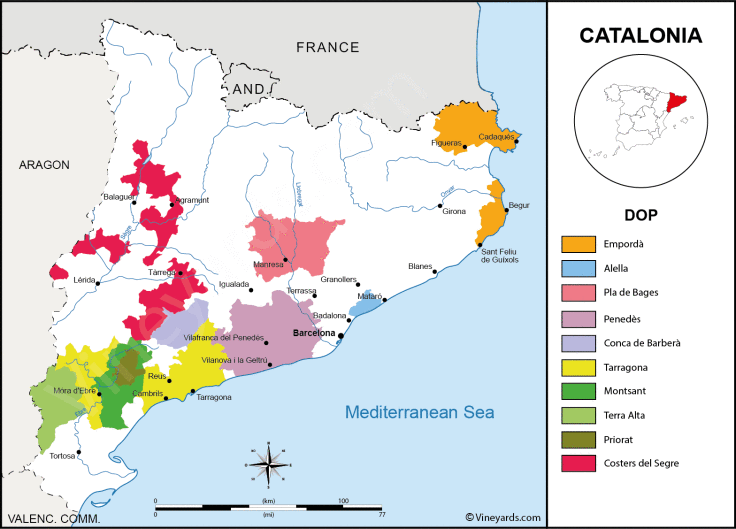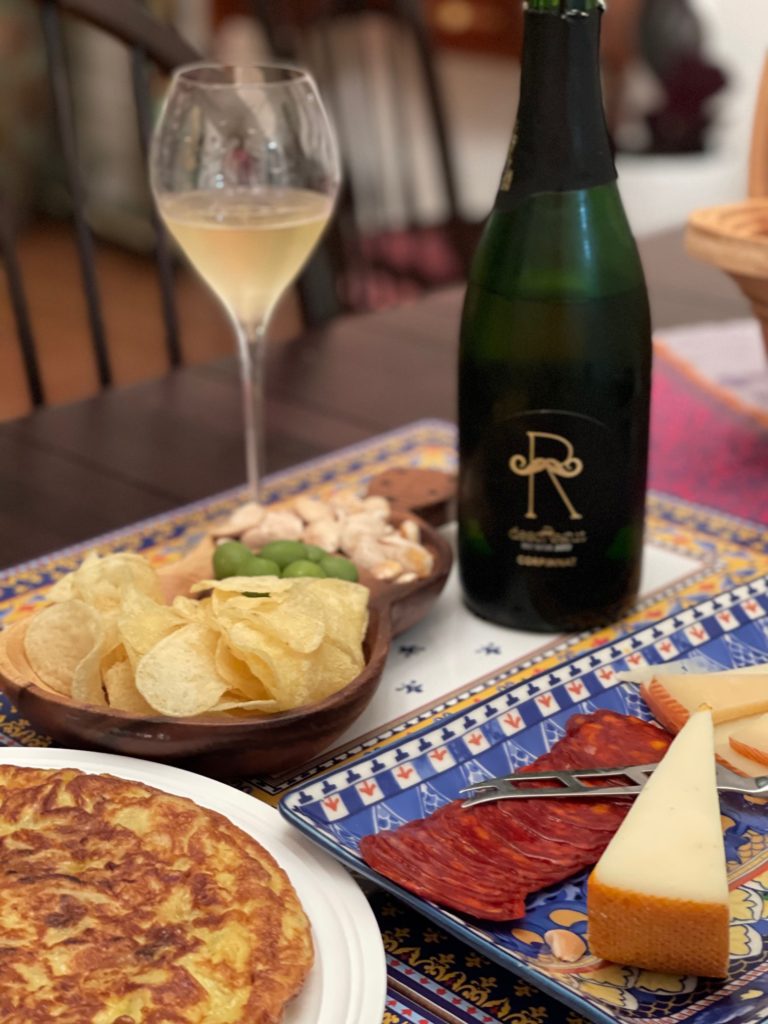The World Wine Travel blogging group is spending the year virtually touring Spain. This month, we are diving into Catalonia ( Catalunya in Catalan). The region, located in north-east Spain has a long, and distinguished tradition of winemaking. It is believed the Phoenicians and Greeks introduced viticulture to the region around 400 B.C.

The capital of this dynamic wine-producing region is flamboyant Barcelona. The Catalonia DO was created in 1999. It was Spain’s first region-wide catch all DO that includes all of the scattered vineyards not covered by the region’s 11 other designations. These include Priorat, a DOCa (Denominación de Origen Calificada, the highest classification) and 10 DOs – Emporda, Costers del Segre, Pla de Bages, Alella, Cava, Penedes, Conca de Barbera Tarragona, Montsant and Terra Alta.
I’m diving into Penedès and, to a lesser extent, Cava sparkling wines. Penedès is the Catalonia’s most important viticultural region, in terms volume and the diversity of wine style. It is Cava, Spain’s fresh, and ridiculously affordable sparkling wine that is the at core of success of Penedès. After all, Penedès is the birthplace of Cava. In 1872 Jose Raventós of Codorníu introduced the método tradicional to Spain, after returning from a trip to Champagne.
Today, approximately 90% of Cava is produced in Catalonia, with 75% made in San Sadurní d’Anoia in Penedès, where Cava was first created. Cava is “most often comprised of Parellada, which gives fragrance and finesse; Macabéo, which gives freshness and acidity; and Xarel-lo, which provides body” explains Winebow .
Prosecco, however, has taken over in the “budget bubbly” sector, and Cava has been fumbling to find its place, which has in turn led to the largest upheaval in its existence. Cava’s Spanish market share competitors, Clàssic Penedès, Corpinnat, and Conca del Riu Anoia, all came about in response to what have been seen as the failings of Cava as a whole explains Miguel Hudin for GuildSomm.
Here’s a look at the Four “Cs” of Spanish Sparkling wine
| Designation | Time Frame | Rules/Regulation |
| Conca del Riu Anoia | 2012 | *Minimum price standard for grapes *Certified organic grapes; minimum age of 10 years for vines *18-months minimum lees aging *Only indigenous grapes varieties grown in the Anoia River Basin *All wines vintage dated + at least 80% estate |
| Clàssic Penedès | 2013 | *First sparkling wine classification in the world to require certified organic grapes. *Traditional and international grapes allowed *No base wines purchased 15 months minimum lees aging *All wines vintage dated + date of disgorgement on label *Sub-Classification of Penedès, alongside DO Cava and DO Penedès Espumoso (which permits wine made using the “ancestral” method |
| Corpinnat | 2018 | *Minimum price standard for grapes *Certified organic grapes, manually harvested *No base wines purchased *18 months minimum lees aging *Sourcing from the geographic core of Penedès * Only indigenous grapes varieties grown in Penedès (Source) *Wine must be vinified entirely on the property |
| Cava | July 2020 Updates | * Reserva Cava must spend 18 months on the lees instead of 15, bringing it in line with Corpinnat * New, overarching classifications include Cava de Guarda (basic Cava with nine months on the lees) and Cava de Guarda Superior, which includes Reserva, Gran Reserva, and Cava de Paraje Calificado. * Cava de Guarda Superior must be organically certified, with a five-year transition allowed, starting in 2020 (again mirroring Corpinnat at this level). *Zones and subzones have been established, the latter of which can only be used on Cava de Guarda Superior. (Source) |
Like most, my wine journey with Spanish sparkling wine began with Cava, but as my palate evolved found myself gravitating toward and trying wines from producers who jumped off the DO Cava ship over quality, viticulture and vinification concerns (e.g ~80% of wine produced by large wineries in DO Cava vinified for them).
That lead me to the stellar wines of Raventos i Blanc from Conca del Riu Anoia, and a very compelling Loxarel from Clàssic Penedès. If you’re looking to taste Spanish sparkling wine beyond Cava, I highly recommend both.
Up next? Corpinnat!
About Corpinnat
The Corpinnat is an EU registered collective brand. Its name is composed of two concepts: COR , the cradle where more than 130 years ago began to beat the first sparkling wines in Spain: and PINNAT , which comes from the etymological root Pinnae which essentially refers to Penedès, in other words, the heart of Penedès.
Its founding member wineries Gramona, Llopart, Nadal, Recaredo, Sabaté and Coca i Torelló were some of DO Cava benchmark producers, who left “because of their conceptual disagreements with the Cava Consejo Regulador. Very low grape prices made it impossible to maintain quality-based viticulture. They felt the prestige of the name Cava was under threat, and were unhappy that they were not allowed to cite a subzone on the label, nor to assure consumers that the grapes came from their own vineyards, nor that the wine had been made on their property. (Source)
In addition to the more stringent standard noted in the table above, the Corpinnat vineyards must be located in one of the 39 municipalities in the most historic area of Penedès.
DO Cava initially derided Corpinnat, elevating its own standards and prestige at an official press conference just after the Corpinnat producers left. But it has had a change of heart. Apparently inspired by Corpinnat, in July 2020 DO Cava established the new set of rules noted in the table above.
2017 Can Descregut Corpinnat Brut Nature Reserva
Can Descregut is a family-owned winery managed by a young couple Marc Mila and Arantxa de Cara, who, after 3 generations growing grapes and making bulk base wine for cava, in 2005 decided to craft their own wines.

The winery is located in Vilobi de Penedès in Alt Penedès sub-zone where they farm 30 hectares of organically (with some biodynamic treatments and a whole lot of care) farmed vineyards. The winery is certified as Organic by the UE. They cultivate the traditional Catalan white grape varieties as Xarel.lo, Xarel.lo Vermell, Macabeu and Parellada but also the Merlot. Their 4 estate vineyard are situated around the winery and in the Penedès hills. The altitude varies from 200 to 500 meters and offers a diverse mixture of soils and microclimates.
The wine is a blend of 55% Xarel.lo, 35% Macabeu and 10% Parellada sourced from their four certified organic estate vineyards. The grapes are harvested by hand and the base wine was 100% vinified at Can Descregut’s winery. The base wine aged with it’s own lees for 6 months, then aged an additional 26 months before being disgorged in July 2020 without the addition of sugars or minimal SO2. Gently fined with bentonite, and no hard filtration.

My tasting notes on the wine follow:
Pale golden yellow color with appealing green apple, brioche, citrus,dried lilac, and a hint of sea spray aromas. On the palate it’s very dry, and with vibrant acidity and a delicate mousse. It shows ripe green apple, quince, lemon, mandarin orange flavors with a very appealing saline minerality and a very satisfying finish. 11.5% abv|SRP~$22. Imported by Manekin Wine Company.
We paired with Spanish inspired tapas including homemade Tortilla Espanola, Manchego, and Etorki sheep milk cheeses, Palacios Chorizo, and Torres Cured Cheese Potato Chips.
Here’s what my fellow World Wine Travel bloggers discovered during their virtual visit to Catalonia:
- Allison and Chris from Advinetures look at Cava: Spain’s Answer to Champagne.
- Andrea from The Quirky Cork enjoys Tapas with Segura Viudas Brut Reserva Cava.
- Camilla from Culinary Adventures with Camilla shares Pollo a la Catalana + Alvaro Palacios Camins del Priorat 2019.
- David from Cooking Chat shines with Mushroom Fricassee and Red Wine from Priorat.
- Gwendolyn from Wine Predator brings Sparkling Wine Secrets: Catalonia Cava from Marqués de Cáceres with Spanish Chorizo Kale Bean Stew.
- Jeff from Food Wine Click looks at Exploring the Variety of Still Wines from Catalunya.
- Linda from My Full Wine Glass showcases Pere Mata Cupada Rosé Cava: Finesse in a Glass.
- Lynn from Savor the Harvest posts Beyond Cava: Loxarel and Gramona Organic Sparkling Wines.
- Melanie from Wining With Mel muses about Innovative Winemaking in Catalunya’s Penedès: Torres Gran Coronas Reserva.
- Nicole from Somm’s Table pens On a Hilltop in Priorat.
- Payal from Keep The Peas joins with Bartender’s Choice from Priorat.
- Robin from Crushed Grape Chronicles focused on Priorat DOQ in Spain’s Cataluña Region and Franck Massard’s 2015 Humilitat.
- Steve from Children of the Grape describes Cava by the Sea.
- Susannah from Avvinare thinks about Two Key Areas in Catalonia Wine Scene: Cava and Priorat.
- Terri from Our Good Life dished about Chicken Empanadas and Azimut Cava.
- Wendy from A Day in the Life on The Farm adds Enjoying Tapas with Spanish Wines from Catalonia.
We’ll be discussing all things Catalonia on Twitter, at 11:00 am EST on Saturday, February 27th. You can join in the fun and find us by using the hashtag. #WorldWineTravel. We hope you’ll join the conversation.
I’m so glad someone featured a Corpinnat and this Can Descregut you got sounds amazing! Dried lilac and sea spray? Si, por favor!
Things were certainly disarranged in the Catalonia world of sparkling wine for a while! Reading in your, the Hudin, and other articles I found, one commonality with the four Cs is their all touching organic to some degree. I’ll be searching for this delightful sounding Can Descregut.
Okay. Wow, Martin! I will definitely be looking for the Can Descregut. It sounds intriguing.
Prosecco certainly seems to have disrupted Cava but thankfully we still get a couple here that still extraordinary value. Just wish we had access to more selection. We don’t seem to get Can Descregut but I’m going to continuing searching!
How they didn’t name their wine Cava Cara is beyond me! Really nice write up on some wines I now want to taste.
The 4 “Cs” of Spanish sparkling wine, just cleared up much of the fog in my head over the sparkling wines of the region. I will admit to using just “Cava” to describe these wines usually and now I will be more aware of the differences. Really helpful!
Andrea is right, your tasting note on this Corpinnat sounds heavenly.
The rise of Corpinnat is certainly a kick in the side to Cava DO – something like what the Super Tuscans did to Chianti? If the results are organic farming and better wine, so be it!
Thanks for sharing the breakdown between the new categories, and I will definitely be on the look out for this wine.
Nicole took the words right out of my mouth! Thank you for that very informative breakdown, and it’s so great that the trend is towards organic growing. Great post, Martin!